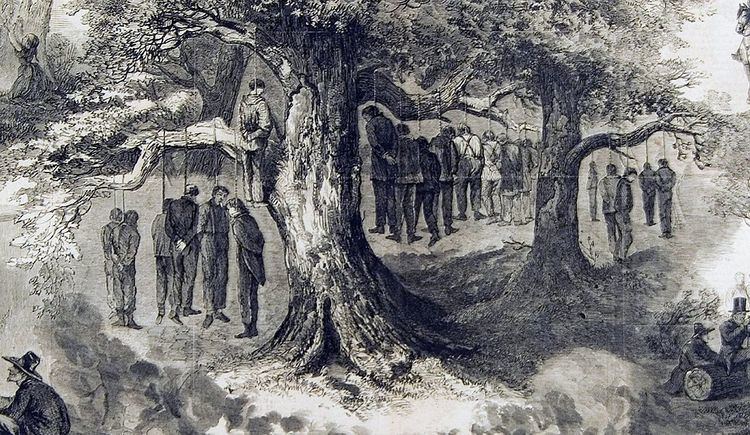 | ||
The Great Hanging at Gainesville was the execution by hanging of forty-one suspected Unionists in Gainesville, Texas, in October 1862 during the American Civil War. Two additional suspects were shot while trying to escape. Most were residents of Cooke County, but residents of neighboring counties were killed as well. It is alleged to be the largest mass hanging in the history of the United States.
Contents
Background
By 1860 only 10.9% of free Cooke county households owned slaves, and 61% of the county electorate voted against secession. In April 1862, the passage of conscription acts prompted thirty Cooke county men to sign a petition, objecting to the exemption of many large-scale slaveholders from the draft. They also formed a "Peace Party", whose members pledged to resist Confederate conscription. However, area slaveowners suspected that the group was colluding with pro-Union forces from out of state, and on the morning of October 1 state troops led by Colonel James G. Bourland began arresting suspected Unionists. 150 men were arrested in thirteen days.
Trials, executions, and lynchings
A hastily formed "Citizens Court" of twelve jurors with no legal status in Texas law, began trying men for insurrection and treason on simple majority vote. After eight convictions the jury changed to 2/3 majority vote for conviction. This resulted in reversal of the last conviction. Those convicted were sentenced to hang within two days. Some were executed within hours. The jury acquitted several more. A mob then threatened to lynch all of the remaining prisoners, so the head of the jury gave them fourteen names. These men were lynched on Oct. 12 and 13 without trial. The court adjourned.
On October 16, Colonel William C. Young, who had attempted to moderate the proceedings, was killed while pursuing a group who had killed another man along a brushy creek. This resulted in public outrage. Jurors were replaced, and the acquittals of nineteen prisoners were reversed, resulting in their lynching. Fifty to sixty were released before Confederate and state courts finally halted the Citizens Court. 41 men had been hanged in Gainesville in October 1862, and at least three others shot.
Reaction
Texas newspapers and the state government applauded the hangings. Jefferson Davis remained silent, having already dismissed General Paul Octave Hébert as military commander of Texas on Oct. 10 for imposition of martial law and harsh measures in enforcing conscription.
Legacy
A state historical marker erected by the Texas Historical Commission in 1963 defends the arrest and execution of these forty-two men, claiming the "Peace Party" had "sworn to destroy their government, kill their leaders, and bring in Federal troops." The speediness of the trial is defended as necessary due to "fears of rescue."
Controversy continues to the modern day. A Gainesville event marking the 150th anniversary of the Great Hanging in October 2012 had to be cancelled due to public outcry. A member of the Cooke County Heritage Society said that, "Gainesville has been hiding from the Great Hanging since it happened." Members of the Sons of Confederate Veterans have created a video calling the victims "traitors".
A memorial for the victims, with a more sympathetic account, was privately constructed in 2014.
